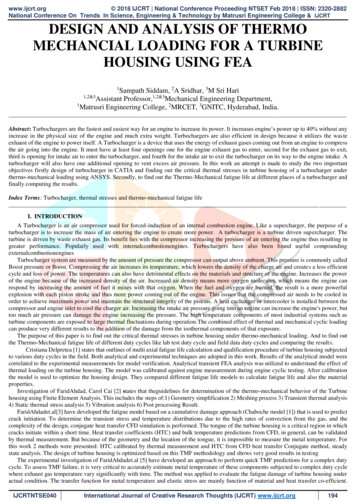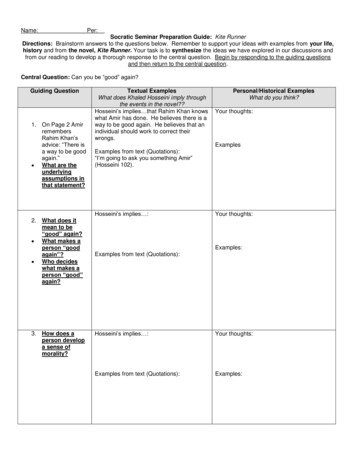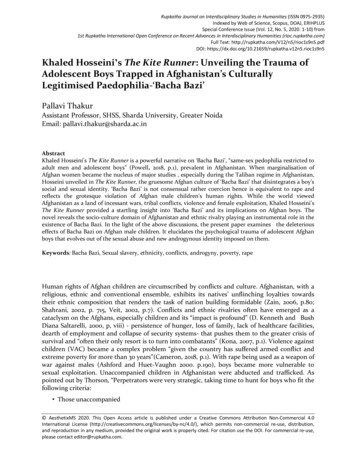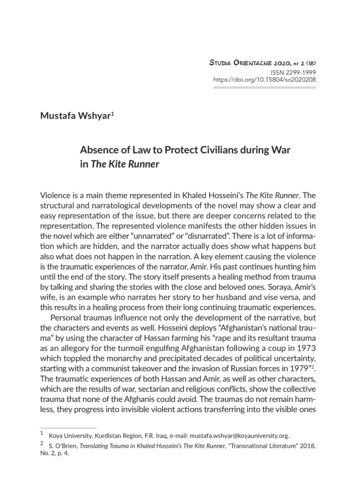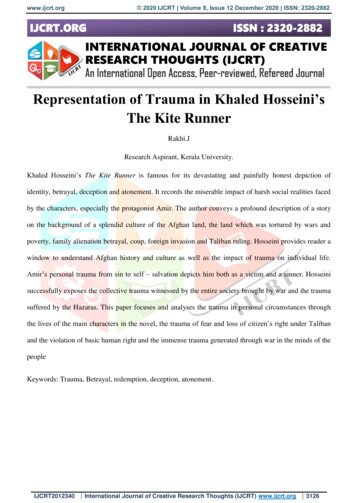
Transcription
www.ijcrt.org 2020 IJCRT Volume 8, Issue 12 December 2020 ISSN: 2320-2882Representation of Trauma in Khaled Hosseini’sThe Kite RunnerRakhi.JResearch Aspirant, Kerala University.Khaled Hosseini’s The Kite Runner is famous for its devastating and painfully honest depiction ofidentity, betrayal, deception and atonement. It records the miserable impact of harsh social realities facedby the characters, especially the protagonist Amir. The author conveys a profound description of a storyon the background of a splendid culture of the Afghan land, the land which was tortured by wars andpoverty, family alienation betrayal, coup, foreign invasion and Taliban ruling. Hosseini provides reader awindow to understand Afghan history and culture as well as the impact of trauma on individual life.Amir’s personal trauma from sin to self – salvation depicts him both as a victim and a sinner. Hosseinisuccessfully exposes the collective trauma witnessed by the entire society brought by war and the traumasuffered by the Hazaras. This paper focuses and analyses the trauma in personal circumstances throughthe lives of the main characters in the novel, the trauma of fear and loss of citizen’s right under Talibanand the violation of basic human right and the immense trauma generated through war in the minds of thepeopleKeywords: Trauma, Betrayal, redemption, deception, atonement.IJCRT2012340International Journal of Creative Research Thoughts (IJCRT) www.ijcrt.org3126
www.ijcrt.org 2020 IJCRT Volume 8, Issue 12 December 2020 ISSN: 2320-2882Representation of Trauma in Khaled Hosseini’s The Kite RunnerIn Trauma Theory there is a blend of memories, introspection , retrospection and flashbacks which areusually coloured by pain, wound and trauma. Also, there is this damage to the psyche occurred as a resultof severe mental and physical distress .Literature substantiates that trauma is often evidence of forms ofdomination and misuse of human power, and through its narration , a fiction can make the readersunderstand the divisions within individuals on how they exist inside and outside their traumas. CathyCaruthy, the famous trauma theorist analysis and set the tone for the critical debate regarding traumassignificance in literature and relation between individual and cultural trauma.Khaled Hosseini , an Afghan born American writer is perhaps the first English novelist to voice thesufferings of the people of Afghanistan .His debut novel The Kite Runner (2003) tells a touching storyabout boyhood friendship destroyed by jealousy, fear , social evils and war. This bildungsroman noveltells the story of Amir’s transition from childhood to adulthood. .Amir’s quest to redeem himself makesup the heart of the novel. The novel explores the strange bond that the protagonist Amir keeps with hisservant friend Hassan. It was a bond that was built on jealousy, superiority feeling and friendship .Amir’s sin and remorse and his eventual redemption becomes the crux of the novel .It also throws lighton the plight of Afghan people caused by recurrent war , racial discrimination, poverty and so onUnder the framework of Trauma Theory and through close reading of the novel ,the present studyseeks to explore the collective trauma of the people of Afghan brought by war, the collective traumasuffered by the ethnic group Hazaras, which is clearly portrayed through its representative Hassan andmost significantly the individual trauma experienced by the protagonist Amir, who has been portrayedboth as a victim and a sinner .The story opens in 2001, where the protagonist Amir, now a successful author is living in SanFrancisco, America. He receives a phone call from his father’s friend Rahim Khan , who shares his desireto meet Amir and he tells Amir he knows of “ a way to be good again “.here starts the technique offlashback. The phone call brings back memories of 1975, when Amir was just twelve. His memories goesdown twenty-six years in the alley of Afghanistan, where he used to fly kites with his friend HassanIJCRT2012340International Journal of Creative Research Thoughts (IJCRT) www.ijcrt.org3127
www.ijcrt.org 2020 IJCRT Volume 8, Issue 12 December 2020 ISSN: 2320-2882The Pashtun boy Amir and the Hazara boy Hassan were raised together in Kabul. Through thesememories we came to analyse the relationship which Amir and Hassan used to have. Hassan being aHazara boy was always loyal and good natured. His quality of forgiveness and how he stood as a pillar ofstrength and support for Amir and his family throughout his life is a trademark of his character. On theother hand we can see a series of multiple shades in the attitude of Amir towards HassanThe friendship between the two grew when they played together , while doing adventures andexploring their surroundings. They enjoyed each other’s company .Amir even embarked their names in apomegranate tree as a token of their friendship. This friendship somehow turned into jealousy mainlybecause of Amir’s insecurity towards his father and the over attachment and concern which Baba showson Hassan Amir has a privileged upbringing, being the representative of Pashtun community and the sonof a wealthy merchant. The only thing which he felt lacking is his father’s love and affection. Babaalways finds Amir weak and even discourages his liking towards writing . According to Baba it’s afemale thing. Baba always tries to satisfy Hassan by giving the same thing which he buys for Amir .Heeven pays for Hassan’s cleft lip surgically operated. It could be said that it is this hidden jealousy whichpaved way to his betrayal towards Hassan.The plight and Trauma which the Hazaras has to face is clearly mentioned throughout the novel.The Hazaras were deprived of education and they were even not allowed to do any business of their own. they were constantly tormented by the majority group Pashtun. They have to work as the servants ofPashtuns , the same thing which Hassan and his father Ali is doing for Amir’s family . Even the Afghaneducation system perpetuate this discrimination . They are least concerned of including the history ofHazara ethnic group in the syllabus. We know it from the words of Amir , that “ In school, Hazaras areleast mentioned “Amir recalls how he has heard even the young neighbourhood kids hurling insults at Hassan ,calling him “ flat nosed “ and “ a load carrying donkey “.we can see Amir too has his Pashtun ideas ofconsidering superior to the Hazaras. Despite the days and nights the two boys played together, despite theseveral adventures and explorations they have executed, Amir never thought or mentioned Hassan as hisfriend . For him Hassan was more of a playmate .Amir eventually develops this feeling of superiorityIJCRT2012340International Journal of Creative Research Thoughts (IJCRT) www.ijcrt.org3128
www.ijcrt.org 2020 IJCRT Volume 8, Issue 12 December 2020 ISSN: 2320-2882considering the relation Baba keeps with Ali . Baba can be seen telling about his childhood with Ali andhow they used to play together .But Baba nevertheless mentioned Ali as his good friend.The discrimination towards Hazaras turned in its most ugly face through the misdeed done by thePashtun boy Assef towards Hassan. Assef, wanted to beat up Amir , for his friendship with Hassan,because he thought all the Hazaras should be eliminated from the country. The feeling of superiority soinculcated in his psyche that it finally developed into hate. In his mind Hassan and Hazaras are worthlessand must be taught a lesson. So he persists and rapes Hassan, an incident which shattered the minds ofHassan and Amir .The Hazaras are portrayed as showing their acceptance as inferior to the Pashtuns. When Amirand Baba escaped to Pakistan and then to California following the soviet union military intervention inAfghanistan, the house was left to Rahim khan. Hassan and his wife continued to be the caretaker of thehouse. Though Rahim permitted their entry in the house, Hassan preferred to stay in the backyard smallhouse, where he used to grew up. Hassan and his wife were massacred by the Taliban , as they protestedagainst the confiscation of the mansion by the troop . Hassan remained as a loyal servant till his lastbreath. Hassan is just one such example of the direct persecution Hazaras face. He is the representativeof the class as a whole.The events which led to the Rape of Hassan and its traumatic impressions in the young lives ofHassan and Amir marked the severity of the novel. Hassan soon collapses into depression and growsdetatched from his immediate surroundings . Amir suffers from the impact of shame and guilt finds wayto distant himself from Hassan. Amir’s mental trauma begins in the point when he failed to help Hassanfrom the clutches of Assef and tried to hide it from others. Being a coward by nature and the longyearning of getting the attention and applaud from his father made him betray Hassan. The weight of sinand regret haunted Amir so much so that he began to distant himself from Hassan and eventually framedHassan for stealing his money and watch. , by keeping them under his pillow.Amir’s shame and guilt follows him after his escape to America also. This sin became a part ofhis human psyche. Amir admits how he ignored the tears on Hassan’s face and his cracked voice. Hassandisplays all those typical signs of trauma for which Amir chose to ignore. Even now ,Amir narratingIJCRT2012340International Journal of Creative Research Thoughts (IJCRT) www.ijcrt.org3129
www.ijcrt.org 2020 IJCRT Volume 8, Issue 12 December 2020 ISSN: 2320-2882those incidents in the present , is unable to name Hassan’s assault as Rape .instead he refers as“something that happened in the valley “ (74). Amir tried to vent this suffocation of remorse , betrayaland sin through his writings. He was trying to find atonement through the rearrangement of past events.Though he remains successful as a author, he was incapable of leaving his past behind. He was carryingthat part of sin wherever he goes. Amir blamed his past actions when he came to know that he and hiswife Soraya cannot have baby.The wound of trauma began to heal , when Amir met Rahim khan at Pakistan and came to knowthat Hassan was his half-brother and the condition of Hassan’s boy Sohrab in the Taliban camp. Amir’spath to redemption starts when he believe that he can redeem himself from what he did to Hassan bysaving his son Sohrab. He knows that he will never be able to say sorry to Hassan .Amir decides torescue Sohrab from the orphanage , where he meets Assef, now a Taliban leader. Assef has kept Sohrabas a dancing boy and as sex slave.Amir risks his life to release Sohrab from the clutches of Assef.Amirhas been beaten hard. Sohrab wins the fight for Amir by using his slingshot hitting the left eye of Assef.Thus Amir did what he failed to do years ago.Amir thus find redemption by not only hitting Assef , but saving Hassan’s son from a dark andhaunting life. Amir adopts Sohrab and takes him back to America. The ending of the novel sees abeautiful picture of Amir flying kite for Sohrab saying, “ For you a thousand times over “.The theme of Rape that is prevalent in the novel mirrors not only the hardships that Hassan has toendure . It is not just the rape of one individual. It is the rape of the entire Hazara community . It showshow this ethnic minority has been thrashed by Pashtuns on one hand and Taliban on the other hand. Thenovel also focuses on the collective trauma faced by the people of Afghan because of war and because ofthe Taliban regime. The novel depicts the haunting pictures of desperate children out of poverty. It showshow a man tries to sell his artificial leg , inorder to feed his children. The picture of adulterous couplebeing stoned to death, hanging bodies on the tree and suicide on the way of escape. Taliban dominanceover people and places is a display of terror. Assef like the Taliban manipulate the ideologies of war andviolenceIJCRT2012340International Journal of Creative Research Thoughts (IJCRT) www.ijcrt.org3130
www.ijcrt.org 2020 IJCRT Volume 8, Issue 12 December 2020 ISSN: 2320-2882In “ Trauma and Recover”: Judith Lewis Herman states : Remembering and telling the truth aboutterrible events are prerequisites both for the restoration of social order and for the healing of individualvictims “. For Amir , it is his act of writing which helped him handle the evil side of his past life. Themore he matured, the more he started to re- discover himself, the intensity of sin he is bearing and thewant of gaining redemption. It is this desire to redeem himself, made him travel back to Kabul and saveSohrab from the clutches of Assef. Thus he finally got salvation from the sin he did to Hassan nearlythree decades ago.Hosseini’s The Kite Runner finds place as a trauma fiction by employing child characters toexpress the mental trauma they experience , the painful images of war and the racial and national traumaof the Afghan land. Hosseini successfully employs trauma as a personal and social phenomenon andthere by constructing restoration of social order and the healing of individual pain in current Afghansociety.REFERENCES1.Hosseini,Khaled. The Kite Runner. Newyork penguin, 2003.2.Caruthy,Cathy. Unclaimed ExperienceTrauma,Narrative and History John Hopkins UniversityPress 19963.Wendt, Alexander. "Anarchy is what states make of it." International Organization 1992: 394.Web. 13 dec2014.4.Herman, Judith Lewis. Trauma and Recovery. Basic books, 1997.IJCRT2012340International Journal of Creative Research Thoughts (IJCRT) www.ijcrt.org3131
The Kite Runner Rakhi.J Research Aspirant, Kerala University. Khaled Hosseini's The Kite Runner is famous for its devastating and painfully honest depiction of identity, betrayal, deception and atonement. It records the miserable impact of harsh social realities faced by the characters, especially the protagonist Amir.




